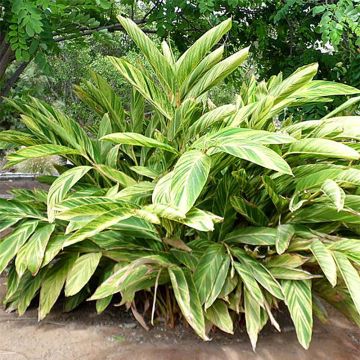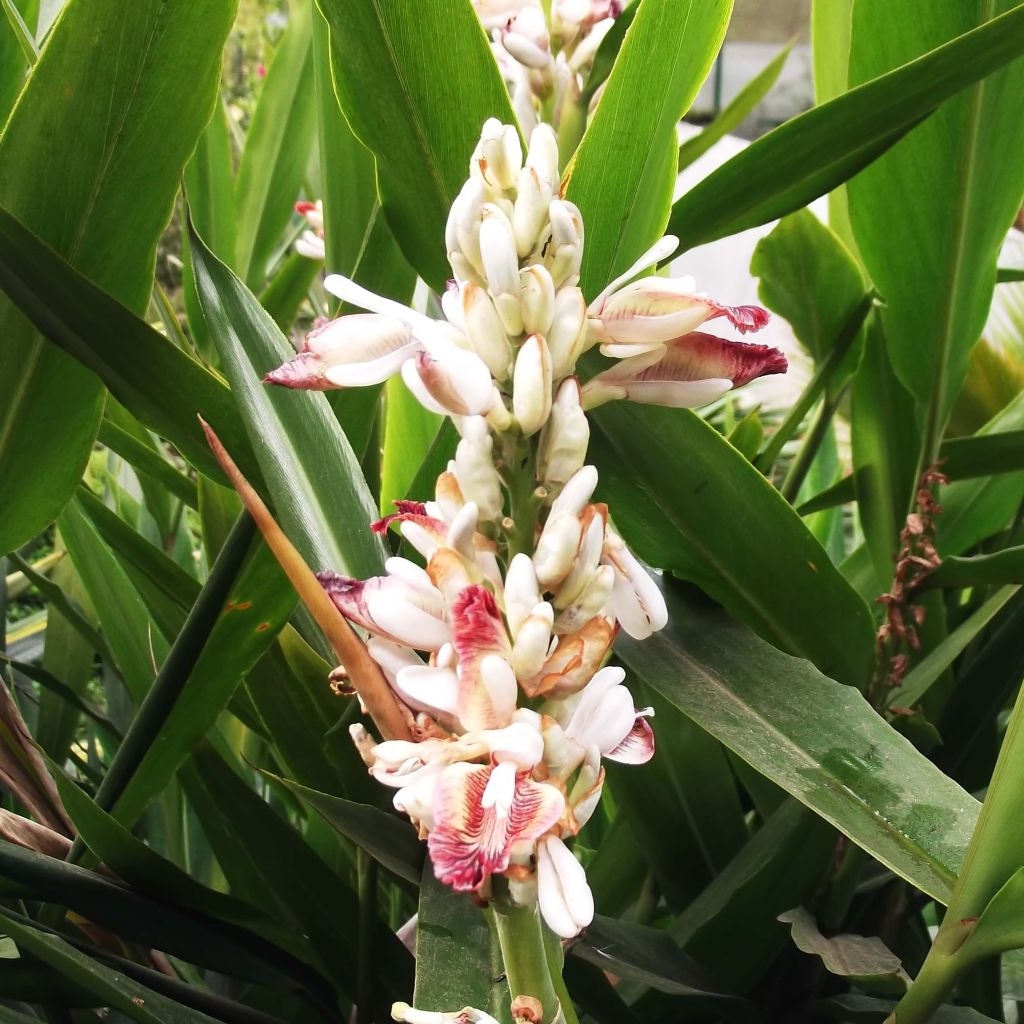

Alpinia galanga
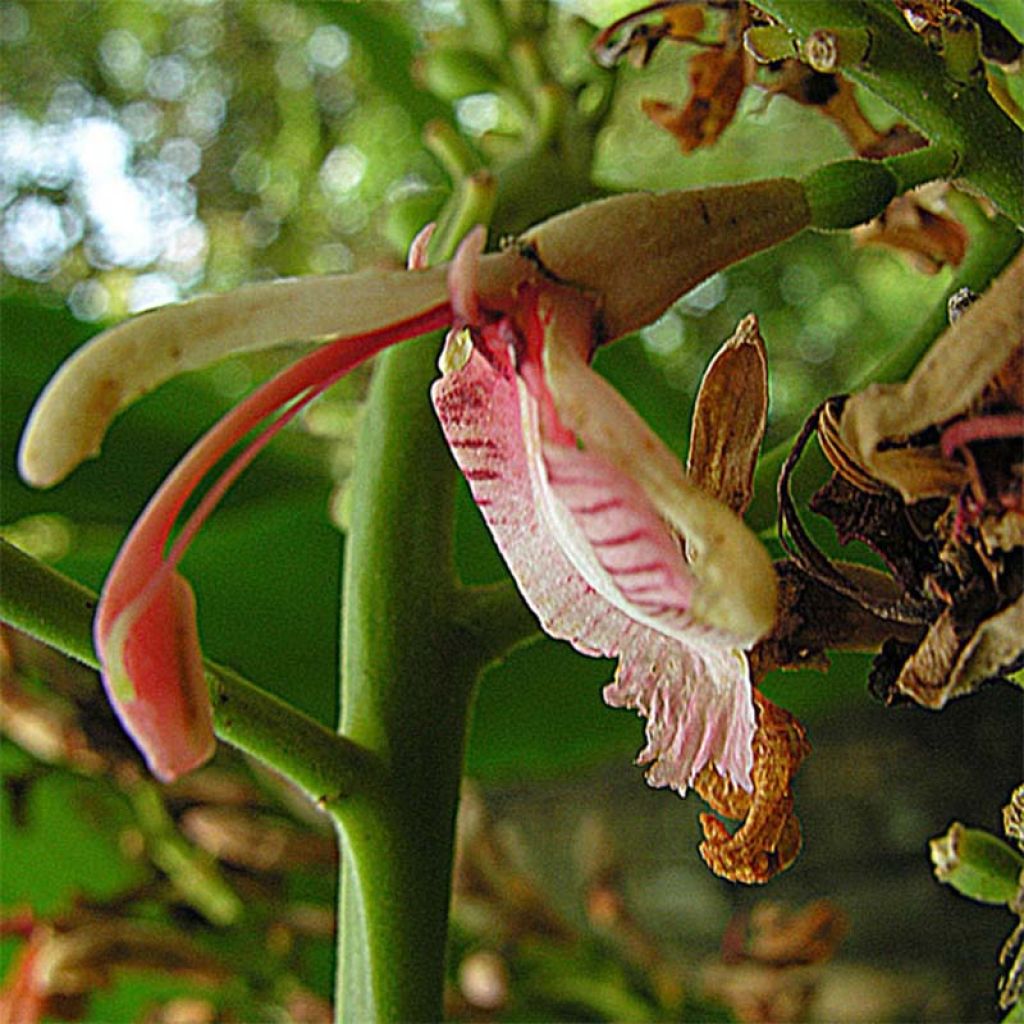

Alpinia galanga
Alpinia galanga
Alpinia galanga
Greater Galangal, Siamese Ginger, Blue Ginger
I don't recommend this young plant, it doesn't grow. It's turning yellow, even though I sent 2 emails to customer service and never got a response.
Johnny, 19/06/2022
This item cannot be shipped to the selected country
Delivery charge from €6.90
More information
Schedule delivery date,
and select date in basket
This plant carries a 12 months recovery warranty
More information
We guarantee the quality of our plants for a full growing cycle, and will replace at our expense any plant that fails to recover under normal climatic and planting conditions.
From €7.90 for pickup delivery and €6.90 for home delivery
Express home delivery from €8.90.
Does this plant fit my garden?
Set up your Plantfit profile →
Description
The Alpinia galanga is better known as Greater galangal, it is a large rhizomatous perennial commonly used in aromatherapy and Asian cuisine, for its aromatic rhizome. It is also an easy to grow and hardier plant than one might think, which is not lacking in elegance and offers a pleasantly fragrant flowering. A bit like a giant canna, it forms a clump of large and long upright leaves larger than a man, from which emerge a few clusters of pale yellow highly fragrant flowers, in summer or autumn depending on the climate. Despite its origins and strongly tropical appearance, red ginger is capable of surviving short frosts of around -12°C, under a good protective mulch. Like many gingers, it appreciates partial shade, cool but loose and well-drained soils, and can be grown in the ground or in containers.
Native to Southeast Asia, more precisely tropical Asia (Thailand, Indonesia, Malaysia etc.), Alpinia galanga is a rhizomatous perennial plant belonging to the Zingiberaceae family. Its vegetation, evergreen in suitable climates, is annual in open ground in climates which are subject to frost. It generally emerges from the ground in April and disappears in autumn. At maturity, a clump of Alpinia galanga will measure around 1.80m (6ft) in height. The knotty, fleshy and underground rhizome, reddish in colour on the surface, has characteristic circular rings. It emits pseudo-stems every year, which are actually tightly rolled leaves, like canna or banana plants. The large, fairly thin but thick leaves form two rows. Their colour is a fairly light green. The dense clump becomes fuller year after year. It flowers in summer or autumn depending on the climate, if the duration of our warm season is sufficient to induce flowering. The terminal cluster inflorescences protrude from the foliage, bearing many small fragrant flowers, ivory-white to pale yellow.
Red Ginger is ideal for adding a beautiful exotic and lush touch to the garden, in not too harsh climates. Planted in partial shade, alongside Hedychium and Colocasia, the exotic effect will be guaranteed! It will also find its place in a very large pot on the terrace, to be stored in cold regions. This Alpinia, evergreen in its original regions, is also an excellent decorative plant for the veranda all year round. Its fragrant flowers are highly appreciated in bouquets. Remember to place it in a partially shaded position and in a soil that remains moist.
Properties: The essential oil contained in the rhizome is called "Amali oil". Highly fragrant, it is used in traditional Asian medicine and modern aromatherapy to treat numerous conditions.
Report an error about the product description
Alpinia galanga in pictures
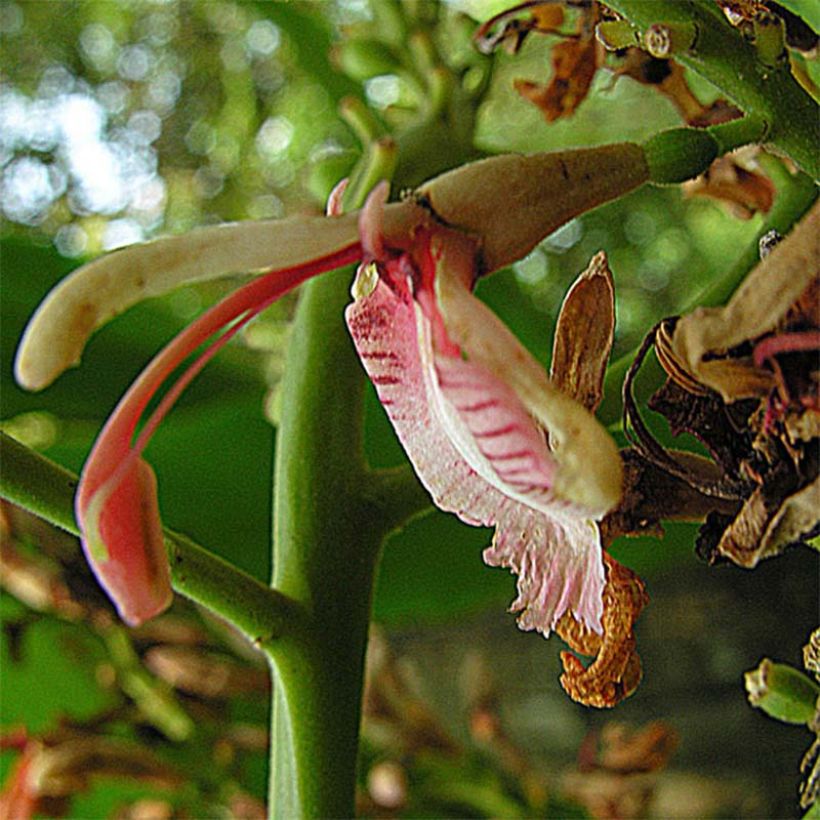

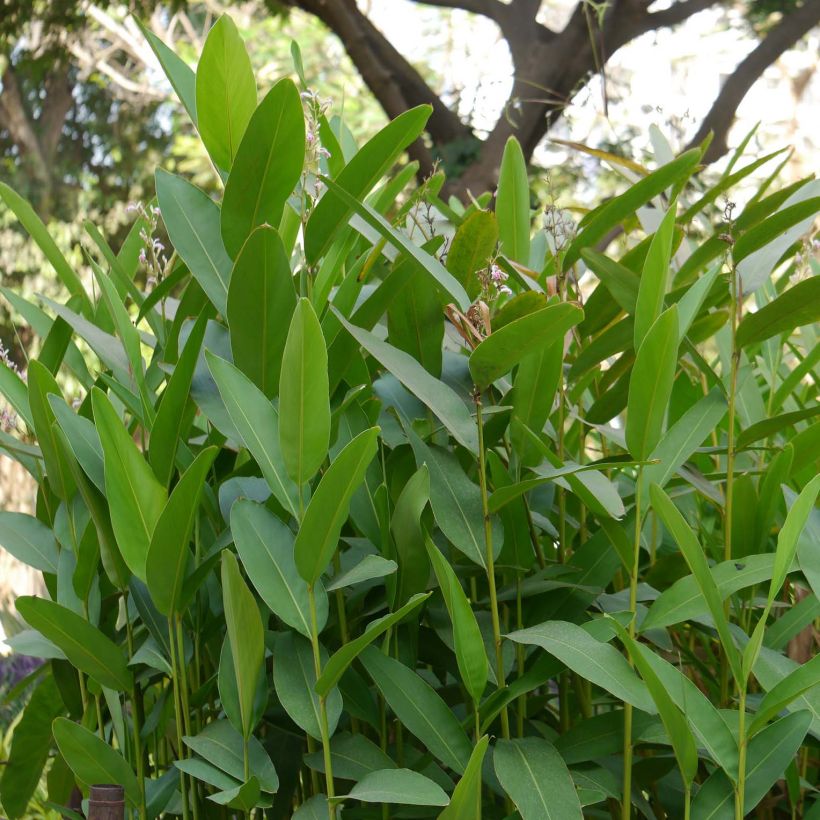

Flowering
Foliage
Plant habit
Botanical data
Alpinia
galanga
Zingiberaceae
Greater Galangal, Siamese Ginger, Blue Ginger
Southeast Asia
Other Alpinia - Galanga
Planting and care
The Siamese Ginger is grown in open ground in our mild regions, or in pots. Plant it after the last frost, in a semi-shaded or, in hot climates, a shaded position, but always bright and sheltered from the wind. It needs well-worked soil, free from any small stones or pebbles, lightened with leaf compost, remaining moist but well-drained to prevent the rhizome from rotting in waterlogged soil in winter. It is not demanding on the nature of the soil, but it is preferable to avoid limestone soils. The rhizome does not tolerate dry soils. Mulching in summer effectively helps to retain soil moisture. You can plant your rhizomes in pots, where they will need to be regularly but not excessively watered throughout the growing season. Apply a little liquid fertiliser every fifteen days, from June to September. Growing in a veranda is an excellent alternative in cold regions. Add compost or well-rotted manure every year in spring. It will be necessary to protect the plant from slugs and snails which are fond of young shoots and flower buds. This plant has no other enemies.
Multiplication: dividing the stumps is done in spring, by taking a portion of rhizome with a dormant bud (an eye).
Planting period
Intended location
Care
-
, onOrder confirmed
Reply from on Promesse de fleurs
Haven't found what you were looking for?
Hardiness is the lowest winter temperature a plant can endure without suffering serious damage or even dying. However, hardiness is affected by location (a sheltered area, such as a patio), protection (winter cover) and soil type (hardiness is improved by well-drained soil).

Photo Sharing Terms & Conditions
In order to encourage gardeners to interact and share their experiences, Promesse de fleurs offers various media enabling content to be uploaded onto its Site - in particular via the ‘Photo sharing’ module.
The User agrees to refrain from:
- Posting any content that is illegal, prejudicial, insulting, racist, inciteful to hatred, revisionist, contrary to public decency, that infringes on privacy or on the privacy rights of third parties, in particular the publicity rights of persons and goods, intellectual property rights, or the right to privacy.
- Submitting content on behalf of a third party;
- Impersonate the identity of a third party and/or publish any personal information about a third party;
In general, the User undertakes to refrain from any unethical behaviour.
All Content (in particular text, comments, files, images, photos, videos, creative works, etc.), which may be subject to property or intellectual property rights, image or other private rights, shall remain the property of the User, subject to the limited rights granted by the terms of the licence granted by Promesse de fleurs as stated below. Users are at liberty to publish or not to publish such Content on the Site, notably via the ‘Photo Sharing’ facility, and accept that this Content shall be made public and freely accessible, notably on the Internet.
Users further acknowledge, undertake to have ,and guarantee that they hold all necessary rights and permissions to publish such material on the Site, in particular with regard to the legislation in force pertaining to any privacy, property, intellectual property, image, or contractual rights, or rights of any other nature. By publishing such Content on the Site, Users acknowledge accepting full liability as publishers of the Content within the meaning of the law, and grant Promesse de fleurs, free of charge, an inclusive, worldwide licence for the said Content for the entire duration of its publication, including all reproduction, representation, up/downloading, displaying, performing, transmission, and storage rights.
Users also grant permission for their name to be linked to the Content and accept that this link may not always be made available.
By engaging in posting material, Users consent to their Content becoming automatically accessible on the Internet, in particular on other sites and/or blogs and/or web pages of the Promesse de fleurs site, including in particular social pages and the Promesse de fleurs catalogue.
Users may secure the removal of entrusted content free of charge by issuing a simple request via our contact form.
The flowering period indicated on our website applies to countries and regions located in USDA zone 8 (France, the United Kingdom, Ireland, the Netherlands, etc.)
It will vary according to where you live:
- In zones 9 to 10 (Italy, Spain, Greece, etc.), flowering will occur about 2 to 4 weeks earlier.
- In zones 6 to 7 (Germany, Poland, Slovenia, and lower mountainous regions), flowering will be delayed by 2 to 3 weeks.
- In zone 5 (Central Europe, Scandinavia), blooming will be delayed by 3 to 5 weeks.
In temperate climates, pruning of spring-flowering shrubs (forsythia, spireas, etc.) should be done just after flowering.
Pruning of summer-flowering shrubs (Indian Lilac, Perovskia, etc.) can be done in winter or spring.
In cold regions as well as with frost-sensitive plants, avoid pruning too early when severe frosts may still occur.
The planting period indicated on our website applies to countries and regions located in USDA zone 8 (France, United Kingdom, Ireland, Netherlands).
It will vary according to where you live:
- In Mediterranean zones (Marseille, Madrid, Milan, etc.), autumn and winter are the best planting periods.
- In continental zones (Strasbourg, Munich, Vienna, etc.), delay planting by 2 to 3 weeks in spring and bring it forward by 2 to 4 weeks in autumn.
- In mountainous regions (the Alps, Pyrenees, Carpathians, etc.), it is best to plant in late spring (May-June) or late summer (August-September).
The harvesting period indicated on our website applies to countries and regions in USDA zone 8 (France, England, Ireland, the Netherlands).
In colder areas (Scandinavia, Poland, Austria...) fruit and vegetable harvests are likely to be delayed by 3-4 weeks.
In warmer areas (Italy, Spain, Greece, etc.), harvesting will probably take place earlier, depending on weather conditions.
The sowing periods indicated on our website apply to countries and regions within USDA Zone 8 (France, UK, Ireland, Netherlands).
In colder areas (Scandinavia, Poland, Austria...), delay any outdoor sowing by 3-4 weeks, or sow under glass.
In warmer climes (Italy, Spain, Greece, etc.), bring outdoor sowing forward by a few weeks.

































